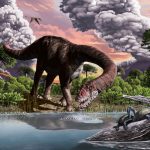How massive long-necked dinosaurs rose to rule the Jurassic herbivores0
- Ancient Archeology, From Around the Web
- November 18, 2020
Volcanic activity may have altered plant life and ushered in rise of dinosaur giants

Volcanic activity may have altered plant life and ushered in rise of dinosaur giants

The final chapter of dinosaur history is a tale stretching across two very different worlds, each a vast supercontinent dominated by its own unique mix of predators and herbivores.

A newfound species of nothosaur may have had a much different lifestyle from its larger kin

Roughly 80 million years ago in the shallow inland sea that once split North America into eastern and western land masses, a fearsome 10-meter-long (33-foot-long) marine reptile with powerful jaws and tremendous bite-force was one of the apex predators.

New simulations add to evidence that the Chicxulub strike is what killed T. rex and its kin

Scientists have discovered a pocket sized dinosaur forerunner that was just 4 inches tall

Perhaps the most iconic dinosaur is Tyrannosaurus rex, a massive predator that lived in what is now North America.

In a forest rebounding after a wildfire 110 million years ago, an armored dinosaur devoured a meal of tender ferns in western Canada before suffering a sudden death – perhaps drowning in a river or a flash flood – and being washed out to sea.

New simulations from Imperial College London have revealed the asteroid that doomed the dinosaurs struck Earth at the ‘deadliest possible’ angle.

Researchers from the Museo Argentino de Ciencias Naturales (Buenos Aires) found a large carnivorous dinosaur of about 70 million years old in the southwest of the province of Santa Cruz. From the specimen were recovered vertebrae, ribs and parts of the chest and shoulder girdle.